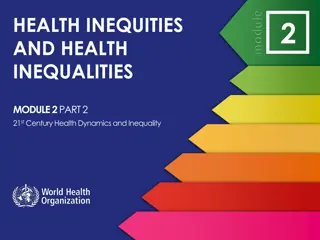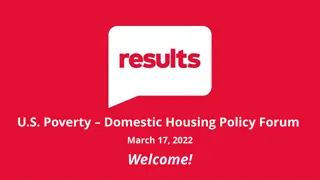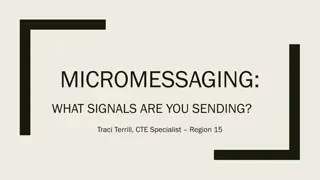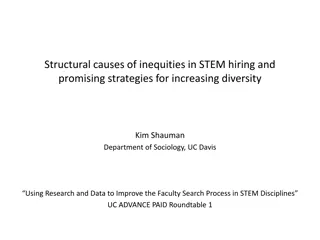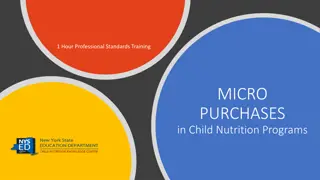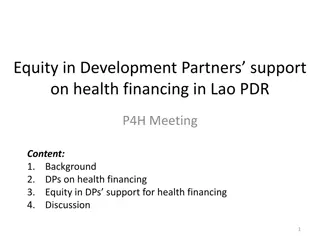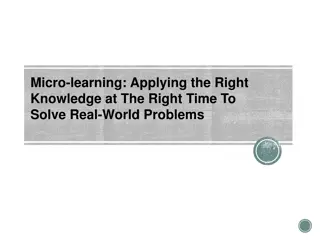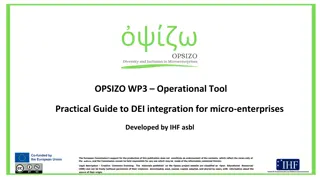Understanding Micro-Inequities in the Workplace
Exploring the concept of micro-inequities, this presentation delves into the subtle messages that devalue individuals, discussing their impact, forms, communication role, and conversion into positive affirmations. Highlighted are the reasons for learning about micro-inequities, emphasizing diversity, inclusion, self-awareness, and leveraging differences for cohesive interactions. The narrative underscores the importance of communication in daily interactions and the significant number of micro-messages transmitted, urging reflection on the type of messages conveyed daily.
Download Presentation

Please find below an Image/Link to download the presentation.
The content on the website is provided AS IS for your information and personal use only. It may not be sold, licensed, or shared on other websites without obtaining consent from the author. Download presentation by click this link. If you encounter any issues during the download, it is possible that the publisher has removed the file from their server.
E N D
Presentation Transcript
October 15, 2015 Micro-Inequities in the Workplace: What Are They and Why Do They Matter? JSAHR Chapter Jennifer Limsky, SPHR, SHRM-SCP Vice President, Employee Relations jennifer.limsky@prudential.com
Agenda Why Micro-inequities? Defining Micro-inequities Forms of Micro-inequities and Communication Impact of Micro-inequities Turning Micro-inequities into Micro-affirmations Benefits of Micro-affirmations Table Exercise Summary and Bottom-line! 2
Why Learn About Micro-Inequities? Another dimension and aspect of diversity and inclusion Broaden our perspective in understanding others Help us better understand ourselves Allow us to leverage differences and build on similarities that exist between individuals Help to understand Micro-messages > Small behaviors with big impact 3
What Are Micro-Inequities*? A subtle, sometimes subconscious, message that devalues, discourages, and ultimately impairs performance Communication interactions that include some and exclude others Subtle slights and snubs that can devalue a person Occur wherever people are perceived to be different. A result of inherent biases regarding anything from gender and race to age and class. These messages can take the shape of looks, gestures or tones of what is said or written The cumulative effect of micro-inequities often leads to damaged self-esteem and, eventually, withdrawal from co-workers in the office. *MIT Researcher Mary Rowe, PhD, 1973 4
Did You Know That? Individuals send 40 to 150 micro-messages in an average 10- minute conversation When micro-messages take the form of micro-inequities, they can appear in a variety of ways; some less obvious than others They may include behaviors that communicate lower performance expectations or exclusion from meetings or discussions 6
Communication is Key We send between 2000-4000 subtle positive and negative messages a day What type of communication are you sending? Verbal Voice Inflection / Tone Non-Verbal 7% 38% 55% 7
How Are Micro-Inequities Conveyed? Verbal Conscious Non-Verbal Unconscious Intentional Subtle Unintentional Overt 8
Some Examples of Micro-Inequities Avoidance of eye contact or rolling of the eyes Cutting-down ideas before they can be considered Repeatedly misspell/mispronounce someone s name Not being acknowledged when walking down the hall Being left out of a discussion Insincere or forced smile What are other examples of micro-inequities? 9
Negative Impact of Micro-Inequities Individual Feeling devalued Decreased self-esteem Feeling like your input is not considered Lack of involvement Poor interpersonal relationships Feelings of not being heard Company High turnover Loss of Revenue Loss in productivity Discrimination complaints Poor recruitment Decreased morale 10
How Can You Turn Around a Micro-Inequity? Micro-Affirmations Small acts, both public and private, often unconscious but very effective which occur wherever people wish to help others to succeed. Tiny acts of opening doors of opportunity. Dr. Mary Rowe 11
What Do Micro-Affirmations Look Like? Consistent feedback that builds on strengths and corrects weaknesses Support when others are in distress, (e.g., project fell through, missed a major deadline, did not win a project bid) Generous acts of listening Gestures of inclusion and caring A simple nod, smile or eye contact 12
Benefits of Micro-Affirmations Likely to help a person do well Consistent, affirmations can be contagious Lead to raising morale and productivity Provide a sense of belonging/acceptance Promotes inclusion in the workplace Illustrates role model behavior for others 13
Additional Ways to Minimize Micro-Inequities Help others feel welcomed; be inclusive Be self aware: Consider your own biases, stereotypes and prejudices Learn more about Micro-Inequities and share with others Be courageous enough to interrupt Micro-Inequities and turn them into Micro-Affirmations What are other ways you can minimize Micro-Inequities? 14
TABLE EXERCISE Discuss an instance(s) when you witnessed or were involved with the occurrence of a micro-inequity . _____________________________________ Did it happen to you or someone you know? What was the situation? What was your reaction? How could you have changed it? ________________________________________________ 10 minutes to complete the exercise. Select a spokesperson from your table for our debrief. __________________________________________________ Disclaimer: No mention of individual s names, division, etc. 15
Summary Micro-Inequities are subtle messages that undermine the value of others in the workplace Our communication, both verbal and non-verbal, are instrumental in sending these messages Micro-Affirmations small acts or gestures of caring and inclusion that consciously affirm others minimize the negative effects of Micro-Inequities What s the Bottom-line? .. A Truly Inclusive Work Environment . 16
Resources Mary P. Rowe, PhD. Micro-Affirmations & Micro-Inequities. MIT. 2008. Stephen Young, Insight Education Systems, The Power of Small. www.insighteducationsystems.com. Caroline Laguerre-Brown, JD. Equity, Diversity & Inclusion. Johns Hopkins University. 2007. Eric L. Hinton. Microinequities: When Small Slights Lead to Huge Problems in the Workplace. DiversityInc. 2004. David Rabb, MA. Understanding the Power of Micro-Inequities. Toni Rogers, Rogers Consulting. Micro-Inequities/Micro-Messages in the Workplace When Little Things Become Big Deals, 2013. 17









